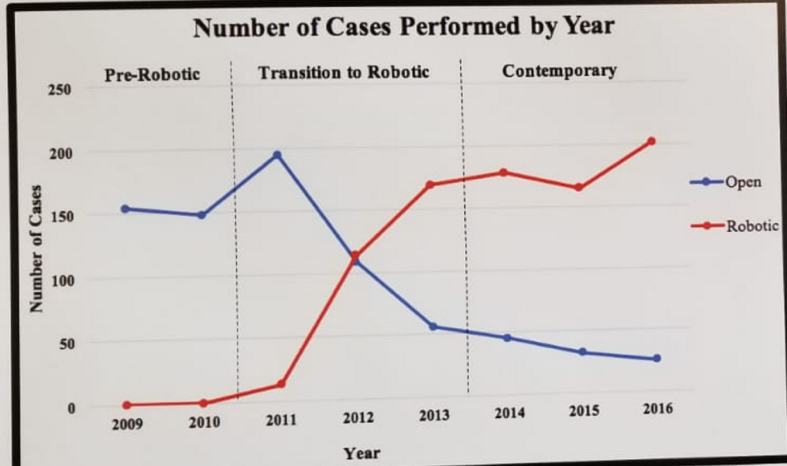This was a large retrospective review of all prostatectomies performed at The Ottawa Hospital between 2009 and 2016. The authors assessed various patient factors, including age, body mass index, Association of Anesthesiologists [ASA] score), operative and perioperative outcomes (length of post-anesthetic care unit [PACU] stay, pain score, length of hospital stay, transfusion rate, readmission or return to the emergency room within 30 days, and hospital cost). The primary outcome was the rate of transfusion during admission. Both univariate and multivariable analyses were performed to identify factors associated with transfusion.
Overall, A total of 1606 prostatectomies were analyzed for the purpose of this study. These were performed by 12 surgeons during the study period with 840 being robotic cases (52%), and 766 open cases (48%). The number of cases performed by year is shown in Figure 1.
Figure 1 – Number of open and robotic prostatectomies performed at the Ottawa Hospital from 2009-2016:

When assessing the rate of transfusion, it was significantly lower in the robotic cases (0.6% vs. 11.2%; p<0.001). The robotic prostatectomy cohort had fewer regional anesthetics (0% vs. 60.3%; p<0.001). Other patients and procedure characteristics are shown in table 1. Additionally, the robotic cases had a shorter length of recovery room stay (155.7 minutes vs. 231.1 minutes; p<0.001), and shorter length of hospital stay (1.4 days vs. 2.8 days; p<0.001). Additional operative outcomes are shown in table 2. As expected, the financial costs were significantly higher with the robotic cases, with $800 higher cost per case (p<0.001).
Table 1- Patient and procedure characteristics of open and robotic prostatectomies performed:

The authors of this study concluded that robotic prostatectomy is associated with improved outcomes when introduced to a program with surgeons of various levels of experience and training. Transfusions and length of hospital stay are decreased when robotic surgery is used for prostatectomy compared to an open approach. In any case, additional studies are needed to determine the true impact of robotic technology on prostate surgery.
Table 2 - Operative outcomes of open and robotic prostatectomies performed:

Presented by: McAlpine Kristen, The Ottawa Hospital, Ottawa, Canada
Co-Authors: Luke Lavallee1,2, Rodney Breau1,2, Daniel McIsaac2,3, Christopher Morash1,2, Ilias Cagiannos1,2, Jocelyn Tufts4, Alan Forster2,4,5.
Author Information:
1. Division of Urology, University of Ottawa, Ottawa, ON, Canada
2. The Ottawa Hospital Research Institute, University of Ottawa, Ottawa, ON, Canada
3. The Department of Anesthesiology, University of Ottawa, Ottawa, ON, Canada
4. The Ottawa Hospital Data Warehouse, The Ottawa Hospital, Ottawa, ON, Canada
5. The Department of Medicine, University of Ottawa, Ottawa, ON, Canada
Written By: Hanan Goldberg, MD, Urologic Oncology Fellow (SUO), University of Toronto, Princess Margaret Cancer Centre, @GoldbergHanan at the 73rd Canadian Urological Association Annual Meeting - June 23 - 26, 2018 - Halifax, Nova Scotia


